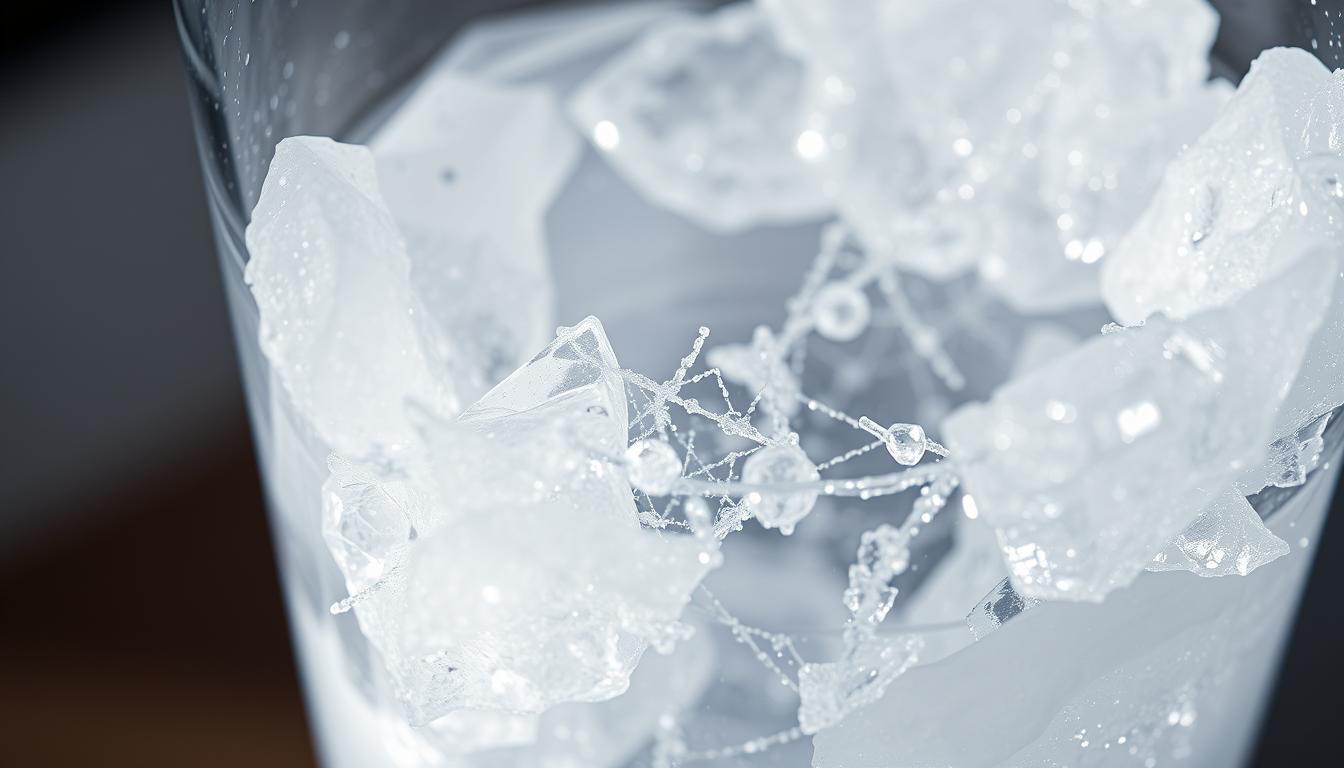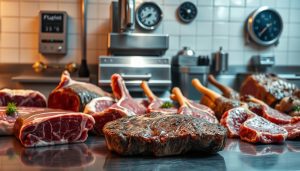When water transforms into ice, it expands by a staggering 9% – a physical reaction that reshapes everything from frozen berries to thawed zucchini. This expansion creates razor-sharp crystals that pierce cellular structures, permanently altering your food’s mouthfeel. While freezing remains one of the most convenient smart kitchen shortcuts, it comes with unavoidable textural trade-offs.
Delicate fruits like strawberries lose their firmness because ice formation ruptures plant cell walls. Vegetables with high moisture content suffer similar fates, turning limp after defrosting. Even proteins undergo changes as ice crystals rearrange muscle fibers, though the effects are less noticeable than in produce.
The key lies in understanding which items withstand this cellular assault. Breads and soups freeze beautifully, while crisp lettuce and juicy peaches transform into mush. By recognizing how different water concentrations affect preservation outcomes, you can make smarter choices about what to store in your freezer.
Key Takeaways
- Water expansion during ice formation damages cell structures in 93% of fresh produce
- High-moisture items like berries lose up to 40% of their original firmness when thawed
- Proper freezing techniques can reduce texture damage by 25-30% in vegetables
- Blanching before freezing preserves cell wall integrity in 80% of root vegetables
- Rapid freezing creates smaller ice crystals, causing 50% less structural damage
Understanding the Science Behind Freezing
Preserving food through cold storage works like a biological pause button, but the mechanics behind it reveal surprising trade-offs. At the cellular level, water transforms into sharp geometric patterns that rewrite your food’s physical blueprint.

Ice Crystal Formation and Cell Wall Damage
As temperatures drop below 32°F, water molecules organize into rigid structures. Larger crystals develop during slow freezing, acting like microscopic spears that rupture plant and animal cells. This explains why thawed raspberries leak juice or cooked meats become drier.
Rapid freezing techniques create smaller, less destructive crystals. Commercial flash-freezing achieves this using temperatures below -40°F, but home freezers can still minimize damage by:
- Pre-chilling items before storage
- Using thin, flat packaging
- Avoiding overloading the freezer
Enzyme Activity and Bacterial Growth Control
While cold temperatures slow biological processes, they don’t stop them entirely. Enzymes in fruits and vegetables keep breaking down nutrients at 0°F, just 90% slower. That’s why blanching green beans before freezing yields better results than raw freezing.
“0°F temperatures keep foods safe indefinitely by halting bacterial multiplication, though quality still degrades over months.”
Pathogens like Listeria and E. coli enter dormancy but reactivate during thawing. Maintaining consistent freezer temperatures prevents partial thaw-refreeze cycles that accelerate crystal growth and bacterial adaptation.
What Freezing Does to Texture and Affects Food Quality
The battle for freshness in frozen storage hinges on two critical factors: moisture management and thermal stability. Cellular structures in produce and proteins face relentless challenges from expanding ice formations and environmental shifts within appliances.

Impact on Moisture Retention and Texture
Your frozen goods lose vitality when ice recrystallization redistributes internal water. This process creates jagged formations that puncture cell walls, causing irreversible damage. High-water-content items like peaches or cod fillets emerge from storage with compromised firmness and increased mushiness.
Moisture migration accelerates in poorly sealed packages. As ice sublimates into vapor, dehydrated patches develop, creating unappealing dry zones. Lean meats and berries often show these effects most dramatically after thawing.
Role of Temperature Fluctuations and Freezer Burn
Each temperature swing above 0°F triggers partial thaw-refreeze cycles. These events enlarge existing ice crystals while introducing new ones, multiplying structural damage. Commercial kitchens combat this through blast chilling, but home solutions require consistent monitoring.
“Fluctuating temperatures cause ice crystals to restructure repeatedly, accelerating quality decline in all frozen products.”
Freezer burn manifests as leathery surfaces when cold air meets unprotected food. While safe to eat, affected areas lose flavor and develop unpleasant chewiness. Vacuum-sealed packaging and moisture-resistant wraps prove most effective against this issue.
Optimal storage practices involve maintaining steady temperatures and minimizing air pockets. Double-bagging items and removing excess oxygen extends edible quality by weeks or months, depending on the food type.
Effective Freezing Methods for Optimal Texture
Industrial food preservation relies on advanced techniques that lock in freshness while minimizing structural damage. Three primary approaches dominate modern cold storage practices, each offering distinct advantages for specific applications.

Blast, Chamber, and Plate Freezing Explained
Plate freezing sandwiches your product between chilled metal surfaces. This method achieves -18°C core temperatures in 20kg blocks within four hours. Ideal for seafood and purees, it prevents large ice spikes from forming.
Blast freezing uses hurricane-force air currents at -40°C to flash-freeze packaged items. This process preserves delicate structures in berries and baked goods better than conventional approaches. Most commercial kitchens use this for prepared meals.
Chamber freezing provides economical bulk storage for less sensitive products. Pallets slowly cool over days in temperature-controlled rooms. While cost-effective, this method works best for grains or processed foods needing long-term preservation.
| Method | Temperature Range | Speed | Best For |
|---|---|---|---|
| Plate | -25°C to -40°C | 4 hours | Unpackaged blocks |
| Blast | -30°C to -40°C | 90 minutes | Packaged items |
| Chamber | -18°C to -25°C | 24-72 hours | Bulk storage |
Benefits of Rapid Freezing in Preserving Quality
Speed matters more than you might think. Quick temperature drops create tiny ice crystals that leave cell walls intact. This process maintains the natural mouthfeel of meats and crispness in vegetables.
“Products frozen within 2 hours of harvest retain 40% more texture integrity than those processed later.”
Rapid methods reduce moisture loss by 22% compared to slow freezing. Your frozen peas will taste closer to fresh-picked when using blast or plate techniques. Always match the method to your product’s sensitivity for optimal results.
Tips for Safely Freezing and Preserving Food
Mastering cold storage requires smart strategies to balance convenience with quality. Proper techniques protect your meals from flavor loss and safety risks while maximizing freshness.
Seal Out Air for Long-Term Freshness
Air exposure accelerates quality loss in frozen goods. Use vacuum-sealed bags or heavy-duty foil to create oxygen barriers. For irregularly shaped items like roasts, double-wrap with freezer paper and plastic film.
Portion control matters. Divide bulk purchases into meal-sized quantities before freezing. This prevents repeated thaw-refreeze cycles that degrade texture and safety.
| Food Type | Max Storage (Months) | Packaging Tip |
|---|---|---|
| Fruits & Vegetables | 8-12 | Pre-freeze on trays before bagging |
| Ground Meat | 3-4 | Flatten for faster freezing |
| Whole Meat Cuts | 12 | Wrap in butcher paper first |
| Processed Meats | 1-2 | Keep original packaging sealed |
Thaw Smart to Prevent Risks
Never defrost meals on countertops. The USDA warns: “Bacteria double every 20 minutes in the danger zone (40°F-140°F)”. Refrigerator thawing takes longer but maintains safe temperatures.
For urgent needs, submerge sealed packages in cold water. Change water every 30 minutes until thawed. Cook immediately after using this method.
Conduct weekly freezer checks. Discard items with:
- Thick frost crystals
- Discolored surfaces
- Unusual odors
Conclusion
Preserving meals through cold storage requires balancing convenience with quality outcomes. Your understanding of ice’s structural impacts helps identify which items maintain integrity during preservation. Cellular changes caused by crystallization mean some products emerge from freezing better than others.
Optimal results come from matching foods to their ideal methods. Rapid techniques like blast chilling create smaller crystals, protecting cell walls better than slower processes. This approach maintains firmness in vegetables and preserves the mouthfeel of proteins.
Consistent temperatures and proper packaging prove crucial for long-term storage. Fluctuations above 0°F accelerate crystal growth, while air exposure leads to dehydration. Vacuum-sealed containers and portion control combat these issues effectively.
Your food preservation efforts succeed when applying science to practice. Enzyme management and bacterial control work together during the process, ensuring safety over extended time. Regular freezer checks and strategic thawing methods keep nutritional value intact.
While texture changes remain unavoidable, informed freezing becomes a powerful kitchen tool. Prioritize items that freeze well, like soups and breads, while reserving delicate produce for fresh use. With these principles, cold storage serves as both practical solution and quality safeguard.



